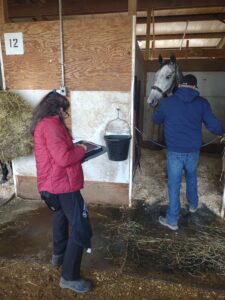In an effort to continuously protect thoroughbred racing in the state of Pennsylvania, the Pennsylvania’s State Horse Racing Commission adopted a new set of guidelines entitled the Equine Safety and Welfare Action Plan. These guidelines are in the form of ten steps, and were put into effect in March of this year. They were developed by industry representatives after an extensive study which included future federal legislation, and guidelines adopted by other states.
First and foremost, in addition to the steps outlined in the new plan, was the addition of an  Integrity Hotline. “This hotline was instituted in March as part of a ten-step action plan to improve equine safety and integrity in Pennsylvania,” said Jason Klouser, Director of Enforcement for the State Horse Racing Commission.
Integrity Hotline. “This hotline was instituted in March as part of a ten-step action plan to improve equine safety and integrity in Pennsylvania,” said Jason Klouser, Director of Enforcement for the State Horse Racing Commission.
 Integrity Hotline. “This hotline was instituted in March as part of a ten-step action plan to improve equine safety and integrity in Pennsylvania,” said Jason Klouser, Director of Enforcement for the State Horse Racing Commission.
Integrity Hotline. “This hotline was instituted in March as part of a ten-step action plan to improve equine safety and integrity in Pennsylvania,” said Jason Klouser, Director of Enforcement for the State Horse Racing Commission.“It’s a recorded line,” Jason emphasized. “An individual can call in and leave a message to voice their concerns regarding equine safety, regulatory violations, things of that nature. It’s for people to report suspicious, illegal, or unethical conduct.”
To date, Jason reported, the Commission received 79 calls. “The Commission looks into and investigates those calls,” he said. “So far, 75 of those calls (cases) have been closed, and the remaining 4 are still under investigation.”
“Those calls range from racing violations; wagering complaints; integrity issues. Numerous ones have been civil in nature, or outside the jurisdiction of the Racing Commission.”
The hotline has already yielded positive results. “Of those calls, there were 3 investigations that were forwarded to the stewards at the respective tracks, and one of those was a jockey who was in possession of an electronic device.”
Included in the new 10-step Action Plan is a requirement for all the thoroughbred  tracks to have a third-party analysis of their racing surface. “They were all completed satisfactorily.”
tracks to have a third-party analysis of their racing surface. “They were all completed satisfactorily.”
 tracks to have a third-party analysis of their racing surface. “They were all completed satisfactorily.”
tracks to have a third-party analysis of their racing surface. “They were all completed satisfactorily.”Additional steps in the plan include the establishment of an equine fatality database. “We’ve always tracked (equine) fatalities in Pennsylvania,” he said. “The Commission created this database to more accurately track the equine fatalities at a racetrack. The perfect number is ‘zero’, and that’s what we strive for. We break it down by quarter, and it appears that the equine fatalities have been down this year.”
A big contributing factor to this drop in fatalities is due to another step in the Action Plan. “What contributes to that is an increased oversight of the regulatory veterinarians of the horses in the morning. We’ve increased the oversight in the mornings during training. The decrease in fatalities can be attributed to all 10 steps on this Action Plan.”
Equally impressive is the out-of-competition testing program, which was established in 2017. “Each year, we work to increase our numbers,” Jason said. This year, we’ve increased the number of samples that have been collected. Year to date, we have collected 865 samples”.
“The horses are selected at random. We’re not looking for therapeutic substances. We’re looking for performance-enhancing substances,” he emphasized.
The Equine Safety and Welfare Plan is detailed in depth at https://www.agriculture.pa.











